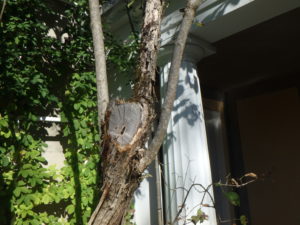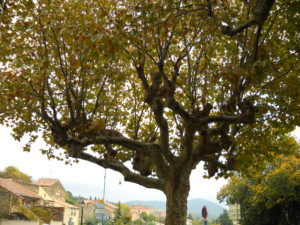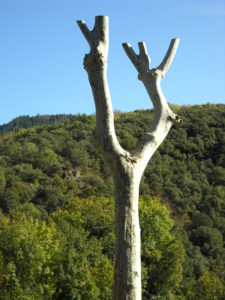Winter Pruning
This is a time of year when little is happening in the garden. Weeds either have been pulled, or won’t be – until next spring. I’ve cut back most flowers, both perennial and annual. The ground is starting to freeze and we’ve had some snow. It’s a good time to be lazy. But … I don’t like to be lazy.
So what can a gardener do? Prune. Trees and shrubs are dormant now, and it is fine to do some pruning. You can see the structure of deciduous woody plants easily now, as their leaves have dropped.
Before you start hacking away, be advised that shrubs that bloom in spring or early summer already have their flower buds ready and waiting for spring. So if you prune heavily, you will lose blossoms. On the other hand, if you have the time now and the plants need work, get to work.
In fact, most shrubs and fruit trees have both their leaf and flower buds. A few exceptions exist, of course: hydrangeas, summer sweet clethra, seven-sons flower tree, witchhazel and franklinia come to mind as woody plants that set their blossom buds on new wood in the spring for summer or fall blooming.
On a recent day I went out to do some radical pruning. I have a white lilac that had gotten too tall. It was 15 or 20 feet tall, and the blossoms were out of reach – and largely out of sight when blooming. It was like that when I bought my house, eons ago, and I cut it right to the ground back then, every bit of it. I didn’t care if it died. In fact I kind of hoped it would because it was so out of control. But the roots sent up new growth and if was a nice sized shrub a while. But life gets busy and all of a sudden it was too tall again. This time I was a bit more controlled.
I have been observing old lilacs to see what others have done with them, and how the plants have responded. At Saint Gaudens National Park I saw that the groundskeeper had cut back old lilacs to about 5 or 6 feet above ground, and that new branches had sprouted from dormant buds on those stems. I’m sure they looked pretty gawky for a year or two, but vigorous new growth had filled in. I decided to try the same.
So I cut back the lilacs, reducing their height to 4 to 6 feet. There will be no blossoms this year, and probably not next year. But there are a few root sprouts that have stems an inch thick, and those may produce blossoms. I just have to make sure those stems don’t reach for the sky.
You might wonder why my lilacs have gotten so tall. I think the answer is that they don’t get enough sunshine. There is a row of sugar maples only about 25 feet away from them, and these create more shade on my lilacs every year. Plants tend to grow tall and lanky if they are sunshine-deprived. They reach for the sun.
Elsewhere on my property that day I cut back my seven sons flower tree (Heptacodium miconiodes). This is a very vigorous fall-blooming tree I’ve had for 15 years or more. It can grow a shoot 6 feet in a year, once established. It is within eight feet of my house, and some of the branches were acting like voyeurs, trying to peak in my bedroom window. They needed some attention.
On one 10-foot stem I cut off all the branches. I am experimenting with a pruning technique called pollarding. This technique is commonly employed with English plane trees in Europe, and I like the look. Every few years trees are cut back to their trunks. The branch locations get scarred, and develop big lumps that then produce multiple new, vigorous branches.
Pollarding is particularly good for fast growing, weak-wooded trees. If those English plane trees were not cut back from time to time, the branches would likely break off from their own weight. That would be dangerous, as they are commonly planted along town streets and in parks. They are great shade trees.
I wouldn’t recommend cutting off all limbs on a tree and leaving just the trunk until you have tried pollarding part of the tree to see how it responds. I have read, for example, that one can pollard maples, oaks and beeches, but I wonder if they would perform well. They don’t grow as fast as some trees, and might take too long to develop an interesting appearance. Or try pollarding a small tree in a not-so prominent place to see how it does.
Fruit trees are most often pruned in late winter or early spring, but you can prune them now if you wish. We have some snow now, which makes ladder work more difficult, but a well-pruned apple tree can be a pleasant sight all winter. So have at it!
Henry’s gardening books are available from his website, www.Gardening-Guy.com. You may read his blog posts at https://dailyuv.com/





